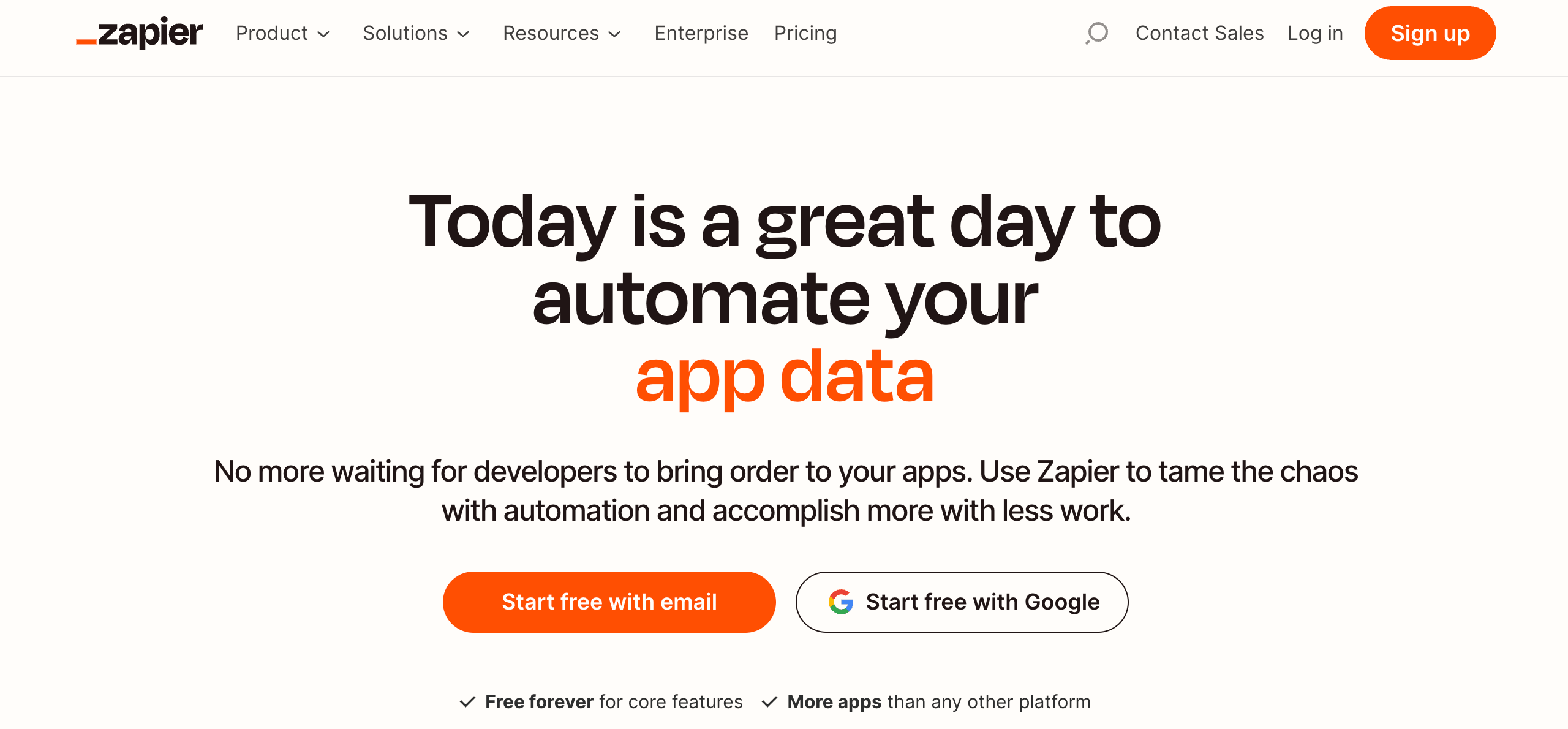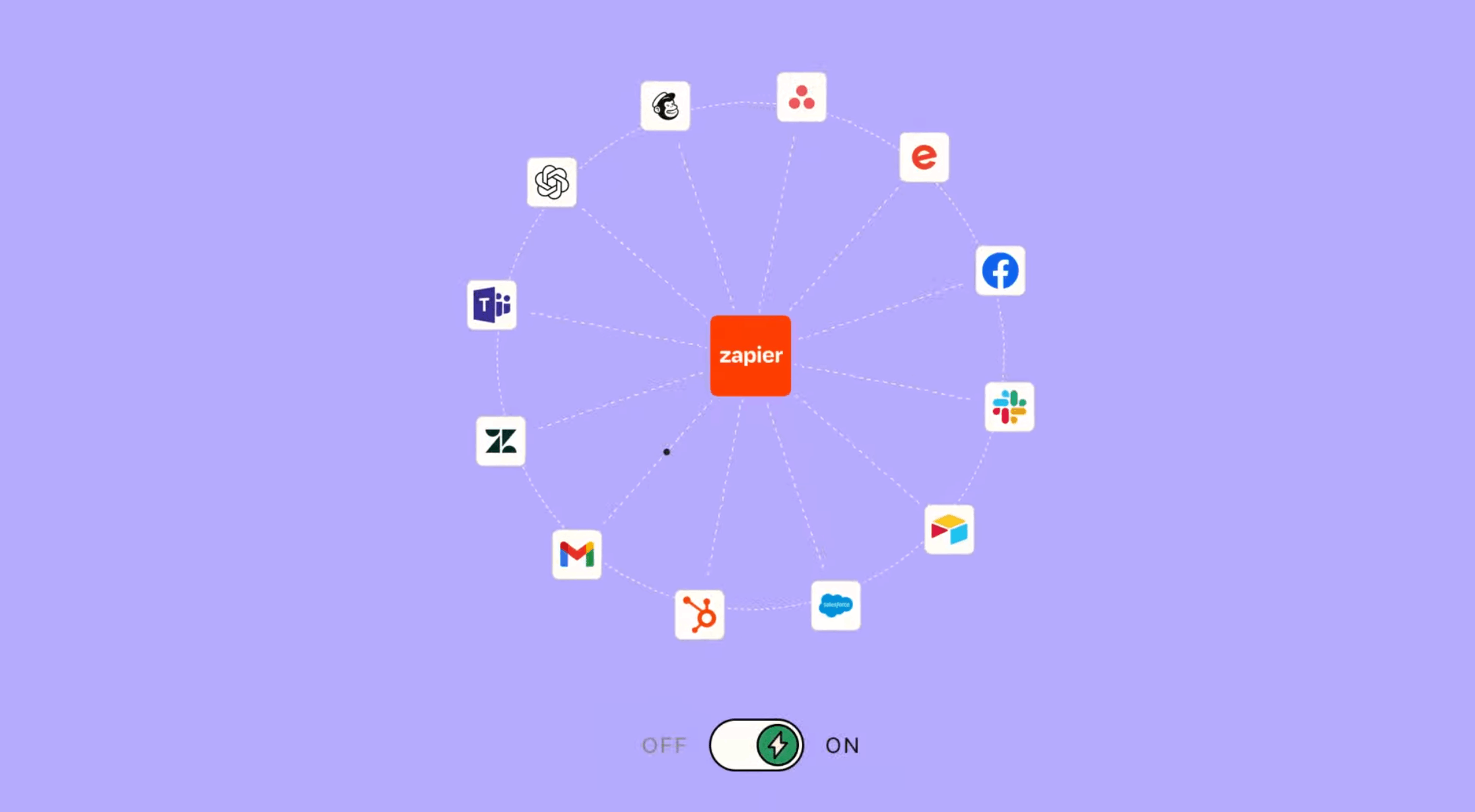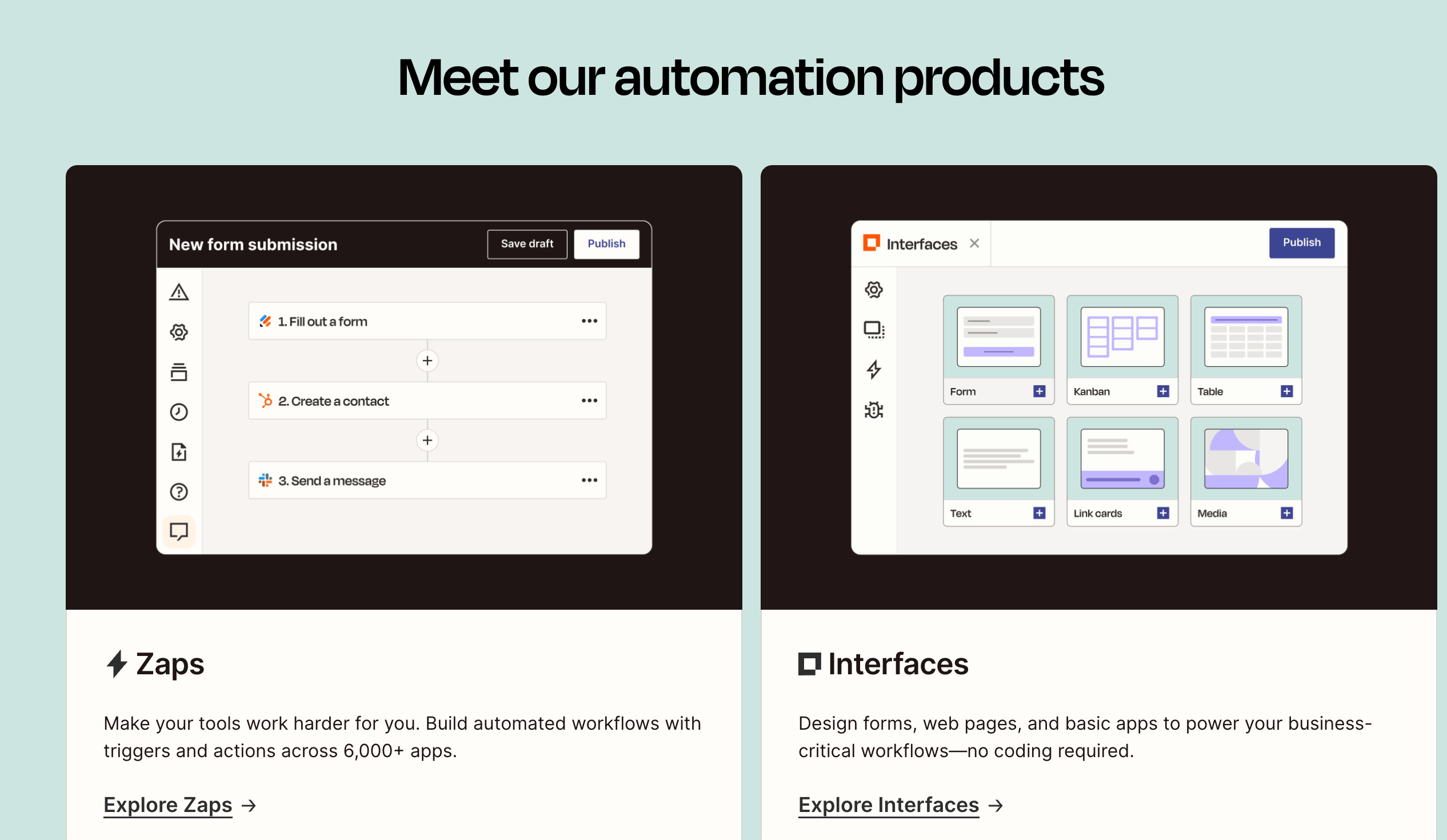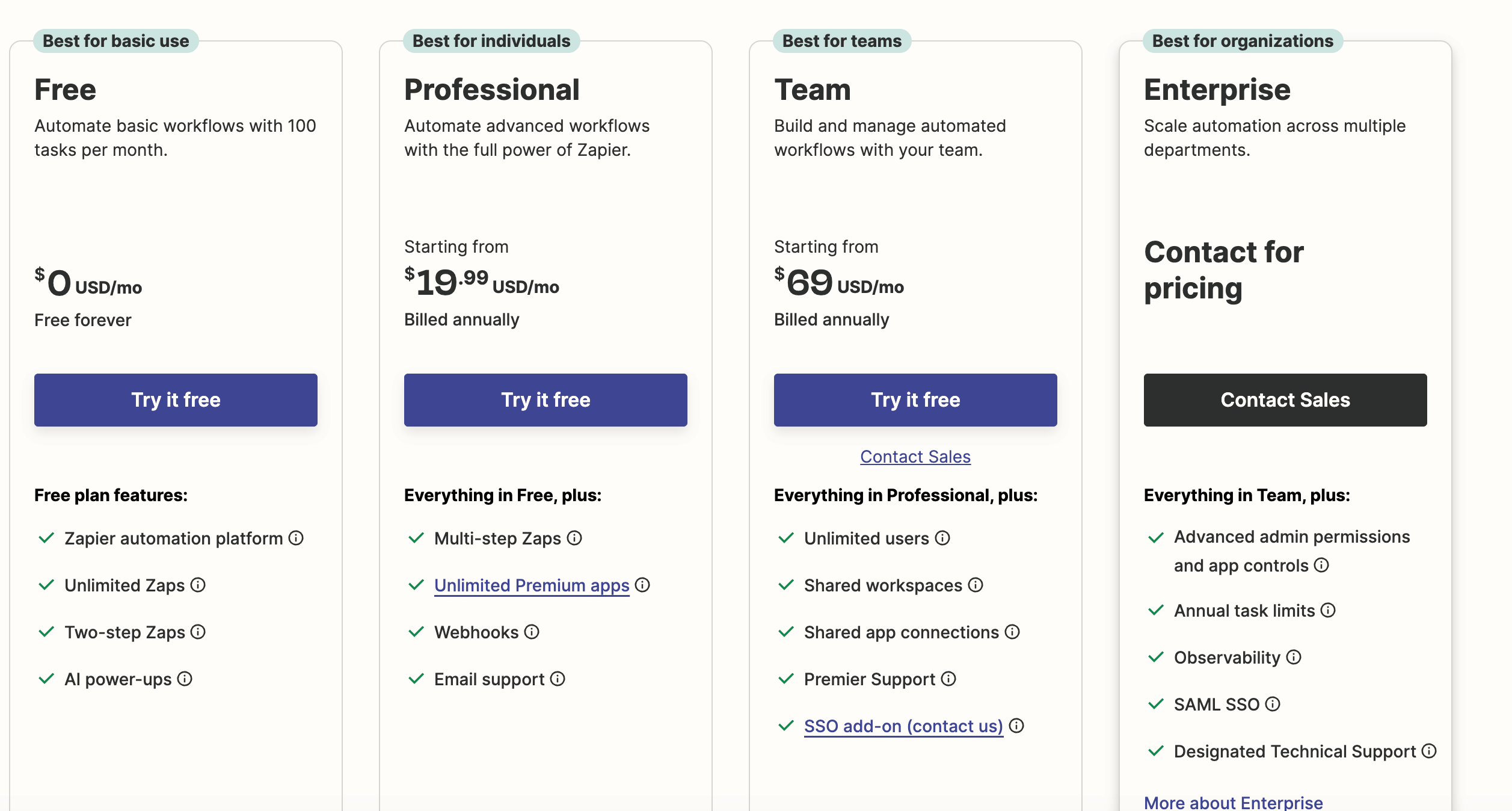










Zapier
automation platform that connects thousands of apps and services, enabling users to automate repetitive tasks and streamline workflows without the need for coding.
Tags:AutomationsZapier alternatives Zapier reviewsZapier reviews & alternatives 2024,feature,pros and cons,price
What is Zapier?
Zapier is a widely recognized automation platform that connects thousands of apps and services, enabling users to automate repetitive tasks and streamline workflows without the need for coding. It operates on a simple concept known as “Zaps,” which are automated workflows that connect your favorite apps and services together.
Zapier official site: https://zapier.com/

Key Features of Zapier
#### 1. **App Integration**
– **Pros**: Supports a vast array of popular apps and services, from email and productivity tools to social media and CRM platforms.
– **Cons**: While extensive, the availability of some niche or newer apps might be limited.
#### 2. **Easy Setup**
– **Pros**: Offers a user-friendly interface and step-by-step guides to create Zaps, making it accessible to non-technical users.
– **Cons**: Some advanced configurations might require a bit of trial and error to get right.
#### 3. **Trigger and Action Events**
– **Pros**: Allows users to define triggers (events that start the workflow) and actions (responses to those triggers), offering great flexibility.
– **Cons**: The complexity of setting up multi-step Zaps with multiple triggers and actions can become confusing.
#### 4. **Error Handling**
– **Pros**: Provides options for handling errors during the execution of Zaps, ensuring smoother operation.
– **Cons**: Managing errors and retries might require additional configuration and monitoring.
#### 5. **Premium Plans**
– **Pros**: Offers premium plans with additional features like more tasks per month, priority support, and advanced search filters.
– **Cons**: Upgrading to a premium plan is necessary for accessing these features, which might represent an additional cost.
### Target Audience:
Zapier is designed for a broad audience, including small to medium-sized businesses, freelancers, and individuals looking to automate their workflows. Its ease of use and wide range of supported apps make it appealing to users with varying levels of technical expertise.
### Conclusion:
Zapier stands out as a powerful yet accessible tool for automating tasks and integrating apps without the need for extensive coding knowledge. Its extensive app support, user-friendly interface, and flexible workflow creation make it a go-to solution for many users looking to streamline their operations and save time.
feature pros and cons
Evaluating Zapier, an automation platform that connects thousands of apps and services, involves considering its features in terms of both their advantages and potential drawbacks. This assessment helps in understanding how Zapier can benefit your workflow automation needs and where it might fall short.
### Key Features of Zapier:
#### 1. **App Integration**
– **Pros**: Offers a vast selection of apps and services, covering everything from email and productivity tools to social media and CRM platforms, making it versatile for various use cases.
– **Cons**: While extensive, the availability of some niche or very new apps might be limited, potentially requiring users to seek alternative solutions or workarounds.
#### 2. **Ease of Use**
– **Pros**: Known for its user-friendly interface and step-by-step guides, making it accessible even to those without technical backgrounds.
– **Cons**: The simplicity might not extend to complex workflows, where users might find themselves needing to delve deeper into the platform’s capabilities.
#### 3. **Trigger and Action Events**
– **Pros**: Allows for the creation of Zaps, automated workflows triggered by specific events in one app and resulting in actions in another, offering high flexibility.
– **Cons**: The complexity of setting up multi-step Zaps with multiple triggers and actions can become overwhelming, potentially leading to errors or inefficient workflows.
#### 4. **Error Handling**
– **Pros**: Provides mechanisms for handling errors during Zap execution, ensuring smoother operation and fewer disruptions.
– **Cons**: Managing errors and configuring retry logic might require additional attention and fine-tuning to ensure optimal performance.
#### 5. **Premium Plans**
– **Pros**: Offers premium plans with additional features like more tasks per month, priority support, and advanced search filters, catering to users with higher demands.
– **Cons**: Access to these premium features comes at an additional cost, which might not be justified for users with minimal automation needs.
### Pros and Cons Summary:
**Pros:**
– **Versatility**: Wide range of supported apps and services makes Zapier adaptable to various business needs.
– **Accessibility**: User-friendly interface and guides lower the barrier to entry for non-technical users.
– **Flexibility**: Ability to define custom workflows with triggers and actions enhances automation possibilities.
– **Reliability**: Error handling features improve the robustness of automated workflows.
**Cons:**
– **Limited App Availability**: Not all apps, especially newer ones, may be supported, potentially requiring alternative solutions.
– **Complexity in Advanced Scenarios**: While easy to use for basic tasks, complex workflows can become cumbersome to configure and manage.
– **Error Management**: While helpful, managing errors and retries adds an extra layer of complexity to workflow setup.
– **Additional Costs**: Premium features may not be necessary for all users, representing an unnecessary expense for those with modest automation needs.
In conclusion, Zapier is a powerful tool for automating tasks and integrating apps, offering a balance between ease of use and flexibility. However, its effectiveness in meeting your specific automation needs will depend on the complexity of your workflows, your budget, and the specific apps you intend to integrate.
plan and price

10 alternatives
For those looking to automate tasks and integrate applications similar to Zapier, there are several alternative platforms available, each with its own set of features and capabilities. Here are 10 alternatives, along with details about what they offer:
### 1. **Integromat**
– **Details**: Offers a visual builder for creating complex integrations and automations, supporting a wide range of apps.
– **Target Audience**: Businesses requiring advanced automation and integration capabilities.
### 2. **Microsoft Power Automate**
– **Details**: Part of Microsoft’s suite, Power Automate focuses on integrating Microsoft products with other apps, emphasizing business process automation.
– **Target Audience**: Organizations heavily invested in the Microsoft ecosystem.
### 3. **IFTTT (If This Then That)**
– **Details**: Provides a free service that creates chains of simple conditional statements called “applets” to automate tasks across various web services.
– **Target Audience**: Casual users and hobbyists looking for quick and easy automation.
### 4. **Workato**
– **Details**: Designed for mid to large enterprises, Workato offers robust integration and automation capabilities, including custom bots and recipes.
– **Target Audience**: Businesses with complex integration needs and larger budgets.
### 5. **Parabola**
– **Details**: Aims to make data transformation and automation accessible to non-programmers, with a focus on data processing and analytics.
– **Target Audience**: Data analysts and teams working with large datasets.
### 6. **Tray.io**
– **Details**: Offers a low-code platform for building custom integrations and automations, with a focus on scalability and reliability.
– **Target Audience**: Businesses looking for scalable, reliable integration solutions.
### 7. **Resilio**
– **Details**: Specializes in IT service management (ITSM) and IT operations management (ITOM) integrations, helping organizations streamline their IT processes.
– **Target Audience**: IT departments focused on ITSM and ITOM.
### 8. **Syncari**
– **Details**: A data unification platform that syncs, cleanses, and enriches data from various sources, helping businesses maintain accurate and consistent data across their systems.
– **Target Audience**: Businesses struggling with data silos and inconsistencies.
### 9. **Cyclr**
– **Details**: Provides a developer-focused API integration platform, allowing businesses to build custom integrations quickly and securely.
– **Target Audience**: Developers and tech-savvy businesses looking for a programmable integration solution.
### 10. **N8n**
– **Details**: An open-source automation platform that allows you to connect apps and services, offering a visual editor for creating workflows.
– **Target Audience**: Tech enthusiasts and businesses looking for a customizable, open-source solution.
Each of these platforms offers unique features and capabilities, catering to a wide range of integration needs from simple automation to complex data processing and system integration. Depending on your specific requirements, such as the complexity of your integrations, your budget, and the types of applications you’re working with, one of these alternatives may be a better fit than others.


